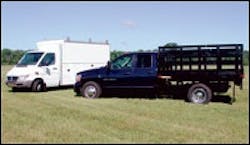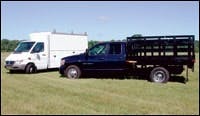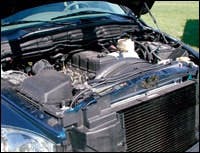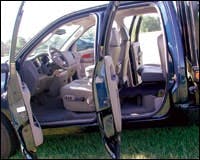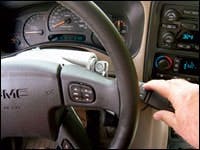Light Trucks Offer Bigger Doses Of Power and Technology
If power corrupts, then buyers of diesel-powered pickup trucks in recent years are up to their window sills in graft and malfeasance. Manufacturers have been steadily outdoing each other in announcing higher horsepower and torque ratings, and another such jump has just been made, this time by General Motors. It is boosting the output of its Duramax diesel to 360 horsepower and 650 pounds-feet, which will make it the strongest engine in the segment.
This news might make you cringe if you now own a Dodge Ram Heavy Duty pickup with a Cummins or a Ford SuperDuty with the Power Stroke. But it's entirely possible that one or both of those builders might leap frog ahead of GM as they've done in the past. That's competition, but it does more than push performance numbers. It drives technology to ever higher levels, because high-tech advances are what make the big numbers possible.
In fact, recent GM releases said much more about the upgrades being made to the Duramax 6600 than the ongoing power and torque war. For 2006, the turbocharged and aftercooled diesel V-8 has gotten a host of improvements, including enhanced electronics in the control module for more precise operation; a variable-geometry turbocharger with recurved and more efficient blades; higher-pressure fuel injection, with injectors reoriented to spray directly onto fast-heating glow plugs, for better cold starts; better cooling of exhaust gas in the EGR system; a stronger water pump; and a revised air-intake system with a resonator to cut noise. Two-piece rocker covers allow mechanics to easily get at injectors and other parts in the cylinder heads.
In the last couple of years, DaimlerChrysler and Ford have also touted the technical advancements made to the diesels supplied by their long-time partners, Cummins and International. Their diesels have likewise become increasingly quiet, clean-burning, and fuel-efficient to where they resemble their 1980s ancestors only in block layout. Anyone turned off by the noisy, smelly light-truck diesels of the past should look again, and maybe has. Because a big majority of Dodge Ram HD and Ford SuperDuty pickups are bought with diesels, and GM reports that its Duramax is quickly gaining popularity as its good reputation spreads.
The builders have meanwhile beefed up the automatic transmissions mated to these torquey engines, and all now offer strong and smooth four- or five-speed units. GM's leap frogging into the '06 model year includes its Allison automatic, which will soon have six speeds, as we'll see in one of these articles.
Meanwhile, the Hurricane Katrina disaster sparked new price spikes for gasoline and to a lesser extent for diesel fuel. This gets us all into thinking again about fuel economy — historically not a high priority for operators of construction trucks, but which must be considered by everyone trying to turn a profit in their businesses. So we have a report on Dodge's Sprinter Eurovan — an entirely new type of commercial truck for American buyers which has become an increasingly popular alternative to North American products with their relatively thirsty high-displacement engines.
It's likely that more buyers will now look at the economical Sprinter, and that Ford and GM, which sell similar small-power-train/big-capacity trucks in Europe, are also likely to look closer at their contingency plans to bring these vehicles to North America. So it could be that your truck equipment future is described on the following pages.
Let's say you need a 1-ton truck to carry supplies to a jobsite or do service work. That means you buy a 1-ton pickup chassis and mount the appropriate body. But wait — now there's a more economical alternative and, maybe, with fuel prices where they are, you ought to look at it.
That alternative is the Euro-style Sprinter, manufactured in Dusseldorf, Germany, by Mercedes-Benz and assembled in Gaffney, S.C., for use in North America. It's designed to sip fuel on a continent where prices have been at the $4- to $5-per-gallon mark for many years, and should save dollars and make sense here. It's sold in the states by certain Freightliner and Dodge dealers; DaimlerChrysler has decided that it should carry only the Dodge name, so Freightliner outlets will soon lose their franchises.
DaimlerChrysler showed off the Sprinter and many other vehicles to the automotive press last summer at its Chelsea, Mich., proving grounds. I quickly paired a Sprinter 3500 with a Dodge Ram 3500 — both actually 2- to 2.5-ton trucks — to see how they'd compare. It's obvious from their appearance that they are rather different in design, and they certainly drive and act differently. Yet with similar hauling capacities, each might do similar jobs.
"Conventional-cab" is a term applied to heavy trucks, but the Ram is also a conventional, with a traditional hood covering a big American power train. The Sprinter is van-like, with a short hood and interior cover that houses a small European-style power train.
The Ram has the highly respected Cummins Turbodiesel. This is Dodge's version of the inline six-cylinder 5.9-liter (359-cubic-inch) Cummins ISB. When Daimler-Benz merged with Chrysler back in the mid-1990s, observers speculated that Cummins would be pushed out by a Mercedes diesel, but the German and American executives running the Dodge Group were not fools. They realized that the Cummins had a following, and they stayed with it.
The current version of the Turbo-diesel, brought out two years ago, has advanced electronics and a highly efficient combustion design, including aftercooling and exhaust-gas recirculation. So it's clean burning, which it has to be by law. It's also quiet, which it should be to measure up to consumers' ever higher expectations and compete with other diesels. If you've been around older versions of this engine, which clatter like crazy, then you'll be impressed with how this one only mutters.
The Cummins is also gutsy, making 325 horsepower and 610 pounds-feet of torque. Late last summer, Dodge boasted of its Cummins "600," which was the strongest light-truck diesel on the market — for about a month, until General Motors trumped it with 605 pounds-feet in its Duramax diesel. The Dodge boys came back with 610, though without the hype. Ford chose to set its International-built Power Stroke diesel at a useful 570 lbs.-ft. That's where the "torque war," as I call it, now stands. But soon GM's Duramax will go to 650 lbs.-ft. and we'll see what happens then.
The point of torque shouldn't be bragging rights but getting the hauling job done, and the Dodge-Cummins diesel has been known for that since its introduction in 1988. Then it had only 160 horsepower but 400 lbs.-ft. of torque — far stronger than competitors of the time — and it became a favorite among work and recreational users. The engine has become a well-mannered monster, and one has to wonder how far it can go in the power and torque department, the competition notwithstanding.
So how can the Sprinter's comparatively puny 2.7-liter (164-cubic-inch) Mercedes-Benz Turbo Diesel possibly do a similar hauling job? It's got only 154 horsepower and 243 lbs.-ft., both odd numbers derived from converting the European measures of kiloWatts and Newton-meters. But thanks to a five-speed automatic with a lively first gear, it moves out surprisingly fast from a standstill and pulls strongly up to highway speeds.
While working hard, the Sprinter's engine spins faster than the Cummins, with the power- and torque-production rpm in the specifications boxes being good indicators of where the engines rev. At cruising speed, the revving difference is less. FedEx, which uses Sprinter delivery vans in Europe and the United States, finds that its drivers can smoke rear tires on take off, at least while empty or with light loads. No, I didn't try that while driving this Sprinter.
I didn't baby it, either. I mashed the gas pedal on the proving grounds' straightaways and plowed it through tight corners. Its engine began running out of breath at 55 to 60 mph, but I moved it past 75 mph without a problem. I was impressed with the Sprinter's abilities in simulated urban settings, at lower speeds and over broken pavement, where it was nimble, quick and rather smooth riding.
The Ram cornered flatter and in general had a stouter feel, though it took the same stretches of broken pavement with more bouncing. Its much stronger Cummins pulled better and would push the truck as fast as any sane driver would want to go. I should note that the '06 Ram 3500 and 2500 are standard with the now-famous Hemi gasoline V-8. For '06, the Hemi gets a cylinder deactivation feature that cuts it back to four cylinders under light loads for up to 20 percent fuel savings. But serious buyers will pick the diesel.
If you send crews out with your trucks, a Ram two-door Regular Cab can carry three people in comfort, while the Sprinter is set up for two. This Ram was a four-door Quad Cab, so it could carry six people in addition to any cargo, and its rear seats folded down wagon-style to carry tools and other valuables instead of extra people.
Each truck's body was representative of how it might be put to work. The Sprinter had a steel utility body with lots of cabinets and drawers, while the Ram had a 10-foot steel-and-wood flatbed with stake sides. Both trucks came from their respective factories as cab-chassis vehicles. The Ram 3500 had the "box-off" option, meaning an owner needn't dispose of a pickup box while upfitting to a different body style.
Aside from the body differences, the gross vehicle weight ratings of the two vehicles are in the same ballpark and suggest that they could do similar jobs, up to a point. Partly because of its more compact cab, the Sprinter can carry 1,200 pounds more in body and payload weight than the Ram, but can pull less than a third of the Ram's tow rating (see boxes). So if you're going to load the truck only, the Sprinter has an advantage; if you're going to lug a loaded equipment trailer, then the Ram, or another big pickup, is the clear choice.
In fuel economy, Dodge cites customer experience in saying that the Sprinter can deliver 25 mpg. A while ago, I saw a comment on the Internet from an expedited freight hauler who claimed he could carry a 1-ton pallet of cargo in his Sprinter van at 80 mph all day or night and get 26 miles per gallon. Of course, "your results may vary," as they would with a Cummins-powered Ram, which might get in the mid- to high teens in mpg.
Against fuel mileage, you'd have to consider price (the two are comparable, though the Sprinter might cost less) and durability (still largely unknown for the Sprinter under American operating conditions; early engines had a sticky EGR valve which caused stalling, and still might unless the valve is serviced).
There's also driver preference and resale, and it's likely that most guys will prefer the Ram. But those who have to buy their own fuel, now at $2.30 to $3+ per gallon, owe it to their wallets to look seriously at the Sprinter.
